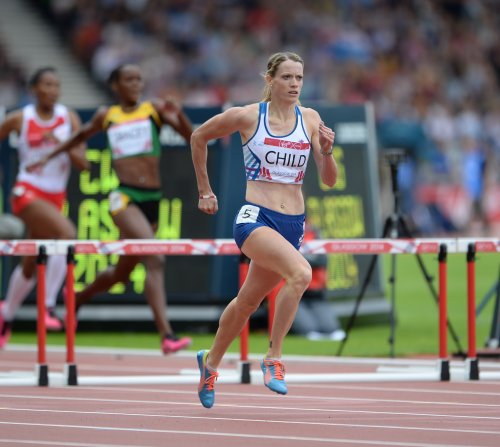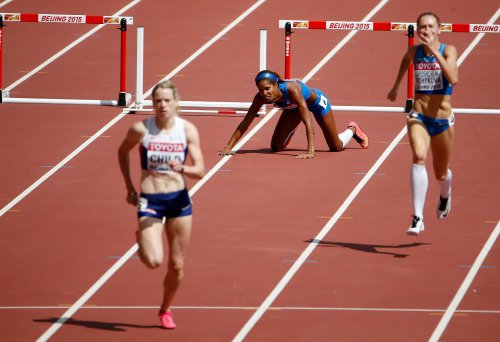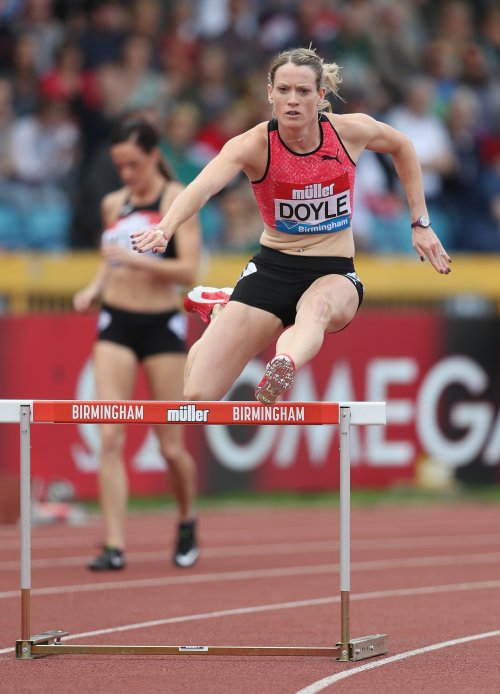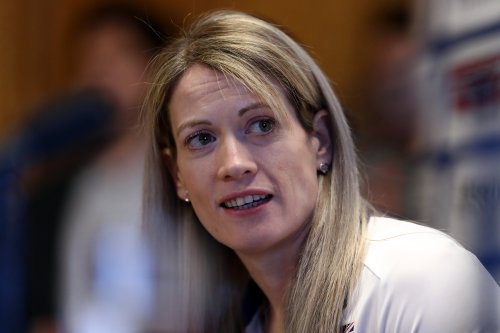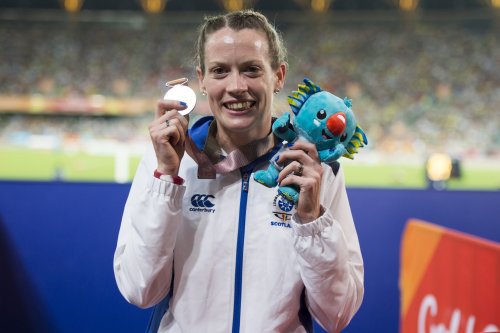Eilidh Doyle, photo by Scottish Athletics
Eilidh Doyle, photo by World Athletics
Stuart Weir did this Q & A on Eilidh Doyle. Stuart was at 150 races, all distances, run by Eilidh Doyle over the years. I like his questions, some out of the ordinary, which is the way a proper interview should be done.
Ten Questions to Eilidh Doyle
Eilidh Doyle is a really thoughtful athlete and a lovely person. We have already posted 5 reflections. In the final one we range over topics which did not fit in any of the previous posts
1. Did you prefer running for Scotland or for Great Britain?
Both! The teams feel quite different because the Scottish team is much smaller. I probably appreciate Scotland more because it only happens every four years – at the Commonwealth Games. I think I am more aware that when I get to compete for Scotland it’s that bit special because it’s rare. I don’t mean that I take Great Britain for granted but you can compete in an indoor championships and outdoor championships and the European teams in the same year. I am equally proud of both but Scotland is that little bit more special because it doesn’t happen very often. In Scotland we are a small nation but we’re a very loud and patriotic nation. Every time I’ve competed for Scotland have been able win a medal and have a lap of honor.
2. What was your favorite training session?
I used to really like the hurdles sessions. Malcolm [Former coach Malcolm Arnold], used to get us to do two runs over 10 hurdles every Thursday – a whole race. Normally I would run 1-8 or twice over five. Malcolm would say “you have to do it in a race, so how are you going to do it if you don’t practice it in training?” And that makes sense – those sessions were big technical sessions. But then I realized that I got so much from those sessions, so they were probably my favorite sessions.
Eilidh Doyle, photo by Martin Bateman
3. Was there a training session you hated?
My least favorite sessions – anything beyond 450, any over-distance work. With Malcolm I used to do flat out 450s but we also used to do two 50 second runs – as fast as you can, as far as you can in 50 seconds. You are effectively running 400 m and I would be coming down the home straight wondering when is he going to blow the whistle. I find it easier to run a distance. Even with 450 you could see the end but running flat out for 50 seconds, you were always dying on the home straight, your legs were going. There in 20 minutes later another one when you would die a bit earlier. But they were great sessions for information and they would tell you a lot. I remember doing it in 2016 and getting to the 400-meter line and thinking “I’m in great shape” so it gave you great information and was really good for your confidence going forward.
But we also did another one which I think was 5,4,3,4,5 which you would back-up and finish on 500 or occasionally 600. They were horrid.
But there’s never anything I really dreaded. Obviously you knew that you’d be feeling lactic but if you did those sessions well, you are really buzzing afterwards and you were ready to go and race.
Eilidh Doyle, photo by Martin Bateman
4. You won medals at just about every Championship – were Diamond Leagues important to you?
Diamond Leagues are important – not so much for winning or getting points – but to expose yourself to that level of competition. I remember when I went to London 2012 I felt really intimidated by other athletes there. I felt overwhelmed with who else was at the warm up track, who was in my heat, who was in my semi-final, thinking these girls are amazing. But then going on to the Diamond League circuit – I got a taste of it in 2013 and by 2014 I was pretty much in every Diamond League where there was a hurdles race and so being able to race these girls week in week out and seeing them around all the time, it humanized them. So when I saw them at a championship I was thinking “I race against you every week”. This is really no different from a Diamond League and that would be the mental focus that I would have. I remember in the European Championship final in 2014 looking around and telling myself this is no different from a Diamond League and you’ve run well in them. So, Diamond Leagues were good for my mental preparation for championships
5. Where do you keep your medals?
At present they are in the box. We have been in this house for about 18 months and there is one room we were going to make into an office and have some photos of my career with my medals in a cabinet. But now that room has become our son’s play room to stop his toys being all over the house. So when we changed that I put all the medals in a box. A couple of special ones, I’d like to have framed with my vest or my number. But at the moment they are just in a box.
6. Do you have a famous sister or does Catriona have a famous sister?
It depends who you ask! If you are an athletics fan, you might say that Catriona has a famous sister. But if you’ve no interest in athletics and you’ve read her books then I’m the one with a famous sister! So it depends who you ask. [Catriona Child is a well-known author https://www.catrionachild.com]
Eilidh Doyle, photo by Martin Bateman
7. You always seemed to race a lot?
Yes, but I loved racing. Malcolm and I would always discuss the season and we kind of knew how many races I needed to peak and we would base the season around that. We would know about how many races I wanted before trials and how many more before the major champs. After the champs, Malcolm would always say “do what you like now” but he always recommended going on the circuit and finishing off well and making a bit of money. I remember in 2013, I stopped my season after Moscow – and Malcolm was saying: “why he would you stop when you were probably in the best shape of your life for those championships?” He told me that in 2013 and I remembered every other year trying to hold on and keep racing. Although mentally with the champs over, you’re not quite there. But I just loved racing and I loved being out there competing. Racing was never a hassle for me because we had done the work and trained hard enough for my body to be able to handle it. It wasn’t as if I was having to negotiate races through injury. I was able to race, bounce back and go and race again.
Eilidh Doyle, photo by Martin Bateman
8. If 400H had been dropped from the program – what alternative event would you choose?
Oh dear. Not by choice but I think the next distance that I might be any good at is 800m. I used to run 800m a lot has a youngster but I didn’t enjoy them particularly. I love watching the 800; it is one of my favorite events to watch, because of the tactics and everything that goes on with it. It would make me nervous thinking about how you’d run it because you don’t know what tactics there will be. My strength is the endurance side of things. For the 400m flat I would need to be a bit quicker and I couldn’t go down a distance so the 800m might be the natural move. But if I could wave a magic wand to become good to anything, it to be pole vault. I would love to do pole vault. The ability that they have got and the confidence to put yourself upside down in the air. It’s incredible.
9. Are there former competitors you would like to bump into socially?
To be fair, the 400 hurdler girls are fairly sociable. At events we might sit together and eat together. I always got along well with Wenda Nel, Sara Petersen and Lea Sprunger. I remember in 2018 in Zurich, the last event of the year when we were rivals, having breakfast together and chatting about what we’re going to do in our time off. And it was really nice to be able to do that.
The person that I never really got to know until maybe 2017 was Perri Shakes-Drayton. We had such an intense rivalry but I don’t think it ever came from us. I think it came from the media because we were the same age, and both running well. Because the rivalry was intense we never really got a chance to socialize or chat. When Perri got injured Meghan Beesley and I picked up the rivalry but we would have breakfast together the morning of a race. But Perri and I never had that relationship – well not until 2017. When Perri came back onto the team in 2017, it is very different and we would sit and chat but to have had more of that earlier would have been nice. And of course Perri and I had the kids at the same time.
10. Stride patterns – did they changed over career?
It did and it didn’t. When I started out I used to do sixteens and alternate legs round the back straight and hopefully come home in 17 on the same leg. In 2014, I really nailed my stride pattern. It was the same stride pattern pretty much every single race – 15 strides to hurdle five. 16 to hurdle seven and 17 home. I really liked that stride pattern with just one hurdle on my non-dominant leg. I am predominantly a left leg hurdler but saying that I don’t think there is a massive difference between the two. I just feel more confident taking hurdles with my left. That is the leg I did my sprint hurdles with when I was younger. When I was in the shape to nail that stride pattern it was great. End of 2014, 2015 and mainly 2016 Malcolm was saying that I should try 15 strides to hurdle six “because, when you’re changing down, you’re losing a lot of time”. Malcolm used to time the splits between hurdles I did see a natural slowing as I went through the race. The difference shouldn’t be that big but between hurdle five and six there was always a big drop in my time. And he would say that I was losing far too much ground there so ideally 15 to hurdle six, 16 to hurdle eight and 17 home. I never really ever got that stride pattern nailed – I got it a couple of times but was far happier doing 15 to hurdle five. And around 2016 when I was running my fastest times, I was really in between stride patterns. But the margins are so fine and sometimes Malcolm would say “play it safe” but make sure you’re not slowing down to take the hurdles, even if you’re shortening your stride.
Author

Caitlin Chock set the then National High School 5k Record (15:52.88) in 2004 and went on to run professionally for Nike. A freelance writer, artist, and comedian in Los Angeles, you can see more of her work on her website, Instagram and Twitter.
View all posts

